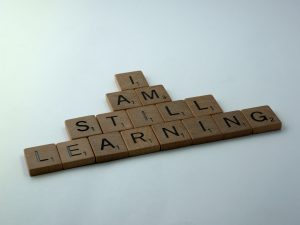20 Helping Students Reflect on Learning
Lynn Meade

Andrew was angry when he got back the grade from the chemistry exam because he spent all night studying for this test. “It’s not my fault, it is that professor who makes the test too hard. Everybody says so. I talked to Whitney and she said that she barely made a C grade and she is usually a straight A student.”
Chances are you have heard your students say things like that. Attribution error suggests that when we are successful, we say that it was because of our hard work but when we fail it is not our fault because of some other circumstances. Our job as coaches is to help students take the time to reflect on what they did that helped them be successful and what they did (or didn’t do) that caused them not to succeed. All too often, students rush from one assessment to the next without taking time to consider how their actions influenced their learning.
As we’ve learned already, there are three main parts of the process of engaging in metacognition on the path to becoming a self-regulated learner; forethought, performance, and reflection. This chapter will explore the final concept by talking about the importance of reflection in self-regulated learning and provide practical strategies for coaches to facilitate this process.

The Practice of Reflection: Making Students Aware of Themselves as Learners
We can empower students to be mindful of their learning processes. We can teach them effective strategies and challenge them to reconsider ineffective ones.
There are three main dimensions of reflection, and by helping students engage in all three, we can help them learn lifelong skills.
- Cognitive dimension-What knowledge was gained?
- Affective dimension-What feelings and motivations were associated with the learning process?
- Behavioral dimension- What actions were taken to achieve learning goals?
Instead of asking superficial questions like “How did you do on the exam?”, coaches should facilitate deeper reflection by using targeted prompts to help students reflect on each dimension.
Cognitive Dimension-What Knowledge Was Gained?
- What did you learn in your class that can help you with other classes?
- How well did you master what you set out to learn?
- What key concepts did you learn in this course that you can apply to other areas of study or your future career?
- What insights did you gain about this subject while preparing for the exam?
- How has your understanding of this topic evolved throughout the semester?
- What did you learn while studying for the exam that helped you to know the subject in a new way?
- How does what you learned relate to other things you’ve been learning or have experienced?
Affective Dimension-What Emotions Were Associated with the Learning Process?
- How did it feel to get your grade back and see how your hard work paid off?
- How did you feel while preparing for this exam? Did those feelings impact your study approach?
- How did you manage your time and energy during your study sessions?
- What motivated you to study for this exam? How can you leverage that motivation in the future?
Behavioral Dimension– What Actions Were Taken to Achieve Learning Goals?
- Which study strategies seemed most effective for this particular exam? Why do you think they worked well?
- In what ways did going to the writing center help you advance your writing skills?
- Now that you have tried studying a little every day, how does that impact how well you remember the material?
- What specific changes could you make to your preparation process for the next exam?
- What patterns have you noticed about when and where you study most effectively?
- If you could change one thing about your study habits, what would it be and why?
- How did you utilize available resources (e.g., tutoring, library resources) to support your learning?
- How well did you avoid sources of interference and stay on task?
- What approach and strategies worked well?
- What didn’t work?
- What do you need to do differently when taking on a similar task?
Consistent reflective practices empower students to identify and refine effective learning strategies, develop greater self-awareness regarding their learning styles and preferences, manage their emotions and motivations related to academic challenges, take ownership of their learning journey, and develop critical thinking and problem-solving skills. Coaches help students develop the metacognitive skills essential for self-regulated learning when they help students reflect on what they learned and how they learned it. Our responsibility as coaches is to equip students with the tools and strategies they need to become effective learners who know why they want to learn, how to learn, and how to reflect on their learning strategies.
Linda Nilson emphasizes, “If we don’t teach them, then who will? Their employers won’t. The buck stops here, at the college level.”
Coaches, what you do makes a difference.
Key Takeaways
- There are three main parts of the process of engaging in metacognition on the path to becoming a self-regulated learner: forethought, performance, and reflection.
- Coaches should help students with all three dimensions of reflection: Cognitive, affective, and behavioral.
- Attribution error suggests that when we are successful, we say that it was because of our hard work but when we fail it is not our fault because of some other circumstances. We want students to take credit for both success and failure.
References
Media Attributions
- caleb-george-VL9ugqp_mko-unsplash © Caleb George is licensed under a CC BY (Attribution) license
- brett-jordan-w7sIj-M5Xyc-unsplash (2) © Brett Jordan is licensed under a CC BY (Attribution) license

